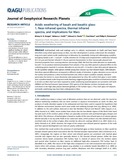| dc.contributor.author | Horgan, Briony H. N. | |
| dc.contributor.author | Smith, Rebecca J. | |
| dc.contributor.author | Cloutis, Edward A. | |
| dc.contributor.author | Mann, Paul | |
| dc.contributor.author | Christensen, Philip R. | |
| dc.date.accessioned | 2018-03-02T19:35:58Z | |
| dc.date.available | 2018-03-02T19:35:58Z | |
| dc.date.issued | 2017-01-24 | |
| dc.identifier.citation | Horgan, B.N.H., R.J. Smith, E.A. Cloutis, P. Mann, and P.R. Christensen (2017) Acid weathering of basalt and basaltic glass: 1. Near-infrared spectra, thermal infrared spectra, and implications for Mars. Journal of Geophysical Research: Planets, 122, 172-202. DOI:10.1002/2016JE005111. | en_US |
| dc.identifier.issn | 2169-9097 | |
| dc.identifier.uri | http://hdl.handle.net/10680/1378 | |
| dc.description.abstract | Acid-leached rinds and coatings occur in volcanic environments on Earth and have been
identified using orbital spectroscopy on Mars, but their development is poorly understood. We simulated long-term open-system acidic weathering in a laboratory by repeatedly rinsing and submerging crystalline and glassy basalts in pH ~ 1 and pH ~ 3 acidic solutions for 213 days and compared their visible/near-infrared (0.3–2.5 μm) and thermal infrared (5–50 μm) spectral characteristics to their microscopic physical and chemical properties from scanning electron microscopy (SEM). We find that while alteration at moderately low pH (~3) can produce mineral precipitates from solution, it has very little spectral or physical effect on the underlying parent material. In contrast, alteration at very low pH (~1) results in clear silica spectral signatures for all crystalline samples while glasses exhibit strong blue concave-up near-infrared slopes. SEM indicates that these spectral differences correspond to different modes of alteration. In glass, alteration occurs only at the surface and produces a silica-enriched leached rind, while in more crystalline samples, alteration penetrates the interior to cause dissolution and replacement by silica. We confirm that glass is more stable than crystalline basalt under long-term acidic leaching, suggesting that glass could be enriched and common in terrains on Mars that have been exposed to acidic weathering. Leached glasses are consistent with both
OMEGA and Thermal Emission Spectrometer (TES) spectra of the Martian northern lowlands and may contribute to the high-silica phases detected globally in TES Surface Type 2. Thus, both glass-rich deposits and acidic weathering may have been widespread on Mars. | en_US |
| dc.description.sponsorship | Engineering Research Council of Canada, the Canadian Space Agency, the Canada Foundation for Innovation, the Manitoba Research Innovations Fund, and the University of Winnipeg for supporting the establishment and operation of the Planetary Spectrophotometer Facility…This work was funded in part by the NASA 2001 Mars Odyssey THEMIS project (Jet Propulsion Laboratory contract #1228404 through Arizona State University) and by the Arizona State University Exploration
Postdoctoral Fellowship. | |
| dc.description.uri | https://agupubs.onlinelibrary.wiley.com/doi/abs/10.1002/2016JE005111 | |
| dc.language.iso | en | en_US |
| dc.publisher | Journal of Geophysical Research: Planets | en_US |
| dc.rights | info:eu-repo/semantics/openAccess | |
| dc.title | Acidic weathering of basalt and basaltic glass: 1. Near-infrared spectra, thermal infrared spectra, and implications for Mars | en_US |
| dc.type | Article | en_US |
| dc.identifier.doi | 10.1002/2016JE005111 | |

